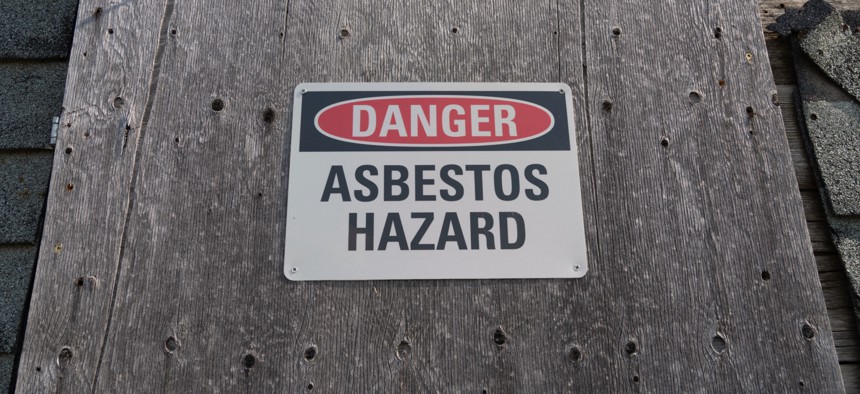
According to the GAO report, it is unknown when 228 buildings with asbestos had their last inspection. Marcia Straub / Getty Images
GSA hasn’t performed asbestos inspections at 66% of buildings requiring them, GAO says
The watchdog found that more than 600 federal buildings weren’t in compliance with GSA’s own asbestos management policy requiring facilities to be examined every five years.
General Services Administration officials tasked with ensuring that the asbestos contained in some federal buildings does not portend a potential health hazard for their occupants have not conducted required inspections, sometimes in decades.
A Government Accountability Office report published Monday examining GSA’s environmental liabilities from managing federal properties found that 638 buildings it oversees have not had inspections within the last five years, as required by the agency’s own asbestos management policy.
A mineral commonly used in constructing and fireproofing buildings until the 1970s, asbestos can cause several forms of cancer when its fibers are inhaled. With more than 1,000 federal buildings containing hazardous materials like asbestos, lead paint and others, GSA’s policies for called for five-year inspections at every building built before 1998 to ensure any asbestos present is contained and undisturbed.
But GAO’s analysis of GSA’s own databases found that 66% of the 955 buildings had not had the required inspections, with 32% of those not receiving inspections between 10 and 20 years.
“GSA officials provided several reasons for the large number of buildings that are not in compliance with GSA’s policy for completing asbestos inspections every 5 years, including limited funding, staffing shortages and incomplete records and database limitations,” the report said. “These officials stated that there is no dedicated funding to complete asbestos inspections, which must compete with other priorities such as major construction projects, or, at one site, electric vehicle projects.”
GSA officials also told GAO that some of its regions only have one staff member, known as an “industrial hygienist”, responsible for monitoring asbestos inspections and the contractors that perform them. Those industrial hygienists also perform other duties like “monitoring asbestos repair and abatement projects and addressing incidents which pose immediate health and safety risks,” which divide their time.
Agency officials also attributed some of the lack of inspection compliance to some buildings not having their completed asbestos inspection surveys uploaded into the GSA’s Inventory Reporting Information System database, where asbestos information is stored and tracked.
The report also noted that regional officials may have difficulty loading the inspection surveys into IRIS due to a lack of staff and the database’s file size upload limitations. In fact, GSA officials don’t have the ability within the database to track when an inspection has been completed because it doesn’t possess the functionality to do so.
“Specifically, while IRIS can store inspection data, the database cannot provide an overview of which buildings have inspections and when the next inspection is due for completion,” the report said. “As a result, GSA headquarters officials said they must conduct time-intensive, manual searches in IRIS to determine the inspection status for the approximately 1,000 buildings that fall under GSA’s 5-year inspection policy.”
GAO noted that of the 638 buildings not in compliance with the inspection policy, it was unknown in 228 buildings when their last inspection was.
GSA officials told the watchdog they requested $500,000 in the fiscal 2024 budget to update the IRIS database and fund additional inspections, which can cost up to $20,000 apiece, and are considering inspection policy changes that could include reducing inspection frequency, excluding low-risk buildings and other potential changes.
GAO offered one recommendation, calling on the GSA administrator to develop a plan to ensure the inspections are conducted according to the policy or to develop a new risk-based policy. GSA officials concurred with the recommendation.







